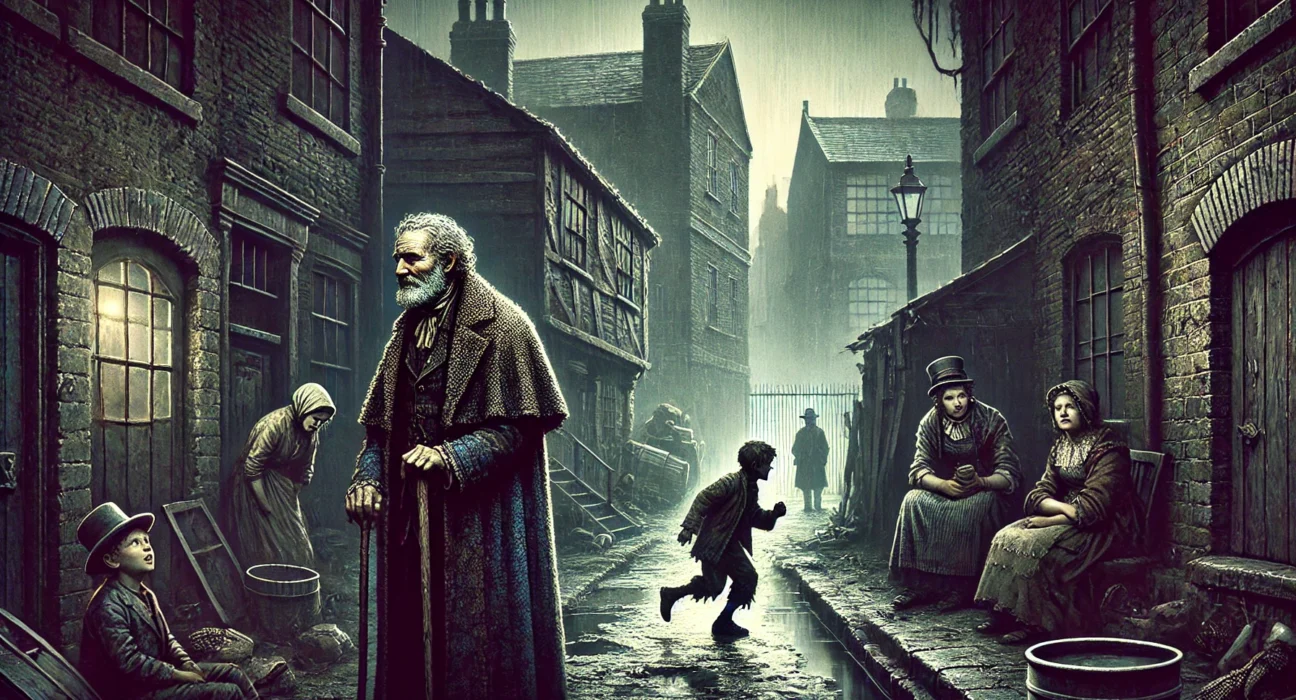The Nether World by George Gissing, published in 1889, is a powerful exploration of life in the impoverished districts of London during the late Victorian era. The novel offers a grim portrayal of the working-class struggle, reflecting Gissing’s characteristic realism and deep empathy for the plight of the downtrodden. His characters are entangled in a web of poverty, despair, and societal constraints, highlighting the harsh realities of life in the urban “nether world” of England.
Plot Summary
Amidst the bleak streets of Victorian London, in the heart of Clerkenwell, Michael Snowdon, an old man with a weathered face and stooped shoulders, walks with purpose through the bitter cold of an early March evening. His journey is not one of hope or joy, but of a quiet resolve to fulfill what he sees as his duty: to use his small wealth to uplift the downtrodden. His past is long and full of hardship, a journey that took him away from London and back again. His return to the city’s gray, crowded streets brings him face-to-face with the life he once left behind, now embodied in his granddaughter, Jane.
Jane Snowdon, a slight, pale girl of thirteen, endures a life of servitude under the brutal hand of Clem Peckover, her cruel caretaker. Clem’s household is one of oppression and violence, where the older girl’s sadistic nature finds its outlet in tormenting Jane. The child bears her suffering with quiet resilience, clinging to the faint hope of escape from this existence. She represents all that is pure and vulnerable in a world where innocence is easily trampled underfoot.
Michael’s mission to find Jane and take her into his care begins after many years apart. He seeks not only to care for her but also to use her as the foundation of his grand plan to distribute his modest fortune among the poor. His idealism is unwavering, though rooted in a harsh understanding of the world’s inequalities. He envisions Jane as the beneficiary of his vision for social reform, yet the complexity of life in the London slums soon complicates his lofty ambitions.
Sidney Kirkwood, a young craftsman who lives nearby, has long harbored feelings for Clara Hewett, a beautiful but self-centered girl from a family that, like so many in Clerkenwell, teeters on the brink of poverty. Sidney is a man of principle, hardworking and kind, but his affections for Clara are met with indifference. Clara, trapped in a world that offers few opportunities for women, dreams of escaping her life of toil and finding a better future. She is ambitious and driven, qualities that make her both admirable and tragic, as her aspirations seem perpetually out of reach.
Clara’s father, John Hewett, is a man worn down by life. The years of struggling to provide for his family have etched deep lines of worry on his face. His pride, though battered by the endless search for work and the humiliation of poverty, remains unyielding. He clings to his family, especially Clara, with a fierce protectiveness, and his greatest fear is losing her to a world he cannot control.
Despite her father’s wishes, Clara is drawn to the prospect of leaving home to work for Mrs. Tubbs, a woman who offers her a chance to escape the drudgery of factory life. But this offer, to serve in a luncheon bar, is fraught with dangers of its own, and her father is adamantly opposed to the idea. Sidney, torn between his own feelings for Clara and his understanding of her desires, advises her father to let her go. He knows that to keep her confined in the life she despises would only push her further away.
As Sidney watches Clara drift out of his reach, his attention turns to Jane, who, despite her dire circumstances, embodies a quiet strength. Sidney takes on the role of her protector, often defending her from Clem’s abuse. He forms a bond with her, one based on compassion and shared suffering. His kindness is one of the few bright spots in Jane’s bleak life, offering her solace in a world that has shown her little mercy.
Meanwhile, Michael Snowdon grows increasingly disillusioned with his plans to reform society. The weight of poverty presses down on him as he navigates the harsh realities of Clerkenwell, where the struggle for survival leaves little room for idealism. His desire to use his wealth for the good of others is met with indifference or suspicion by those around him. The poor, he realizes, are not just victims of circumstance but are often complicit in their own suffering, hardened by years of deprivation.
As Michael’s health begins to fail, his hopes for Jane’s future rest on Sidney. He sees in the young man a kindred spirit, someone who understands the moral weight of responsibility and the importance of compassion. Yet Sidney, too, is caught in the web of his own emotions, torn between his lingering affection for Clara and his growing sense of duty toward Jane.
Clara’s path, driven by her restless ambition, leads her further away from her family and deeper into a world of moral ambiguity. She becomes increasingly estranged from her father, whose old-fashioned values clash with her desire for independence. John Hewett, devastated by her defiance, grows bitter and withdrawn, his once-vibrant spirit crushed by the realization that he can no longer protect his daughter from the world.
As the story progresses, the lives of these characters intertwine, each one grappling with the harsh truths of their existence. Sidney’s unrequited love for Clara, Jane’s quiet suffering, and Michael’s fading hope for a better world all converge in a climactic moment of loss and revelation. In the end, it is Jane who emerges as the symbol of endurance, her future uncertain but still full of possibility. She stands as a testament to the resilience of the human spirit, even in the face of overwhelming adversity.
The grim reality of life in Clerkenwell leaves few unscathed, but amid the despair, there remains a glimmer of hope. Jane’s survival, and the care of those who see her worth, offers a faint but powerful message of redemption in a world otherwise dominated by cruelty and poverty. The characters’ struggles, though marked by tragedy, reveal the complex interplay between personal agency and societal forces, leaving the question of whether true escape from the “nether world” is ever possible
Main Characters
Michael Snowdon: An old man, deeply religious and idealistic, who returns to London after many years abroad. He harbors a strong sense of social justice and seeks to use his modest wealth to improve the lives of the poor, though he faces challenges in realizing these ambitions.
Jane Snowdon: Michael’s granddaughter, a sensitive and kind girl who endures severe hardships under the care of the abusive Peckover family. Jane represents innocence and hope amidst the squalor and is one of the few characters with a chance for a better future.
Clem Peckover: A cruel, dominant figure in Jane’s life. Clem takes pleasure in tormenting Jane, embodying the brutalization caused by poverty and the survivalist mentality of the slums. Her relationship with Jane is one of constant abuse, reflecting the wider social issues at play.
Sidney Kirkwood: A compassionate and hardworking young man who cares for Jane and attempts to protect her from her oppressive surroundings. Sidney also has romantic feelings for Clara Hewett, creating tension in his relationships and contributing to the novel’s exploration of unfulfilled desires and missed opportunities.
Clara Hewett: A young woman who desires escape from the drudgery of her working-class life. Clara is torn between her ambitions and the realities of her social position, embodying the novel’s themes of aspiration and the limitations imposed by class.
Theme
Poverty and Social Injustice: Central to The Nether World is the pervasive theme of poverty and its dehumanizing effects. The novel critiques the societal structures that trap individuals in cycles of destitution, illustrating how lack of opportunity and resources crushes hope and ambition.
Class and Social Mobility: The novel examines the rigid class divisions of Victorian society, showing how difficult it is for individuals like Jane and Clara to transcend their social standing. The characters’ struggles to improve their situations emphasize the lack of mobility and the inescapable nature of their environment.
Dreams vs. Reality: Many characters in the novel dream of a better life, but their hopes are often thwarted by the harsh realities of their circumstances. This theme is particularly evident in Clara’s aspirations for a different life and Michael Snowdon’s idealistic plans for social reform.
Suffering and Redemption: Gissing explores the theme of suffering throughout the novel, particularly through Jane and Michael Snowdon. However, there are glimmers of redemption, especially in the possibility of a better future for Jane, hinting at hope amid despair.
Writing Style and Tone
George Gissing’s writing in The Nether World is marked by its unflinching realism and somber tone. His descriptions of London’s slums are vivid and harrowing, painting a stark picture of the filth, hunger, and deprivation that defines his characters’ lives. Gissing avoids sentimentality, instead offering a raw and honest portrayal of the working class. His narrative voice often reflects a deep moral indignation at the conditions his characters endure, but he stops short of outright polemic, allowing the grim realities to speak for themselves.
The tone of the novel is one of pervasive gloom, with moments of tenderness, particularly in the relationships between characters like Sidney and Jane, offering brief respite. Gissing’s language is rich with detail, and his dialogue captures the dialect and speech patterns of his characters, grounding them in their social and geographical context. The novel’s tone underscores the inescapability of the characters’ plight, with few moments of hope or joy breaking through the relentless bleakness.
We hope this summary has sparked your interest and would appreciate you following Celsius 233 on social media:
There’s a treasure trove of other fascinating book summaries waiting for you. Check out our collection of stories that inspire, thrill, and provoke thought, just like this one by checking out the Book Shelf or the Library
Remember, while our summaries capture the essence, they can never replace the full experience of reading the book. If this summary intrigued you, consider diving into the complete story – buy the book and immerse yourself in the author’s original work.
If you want to request a book summary, click here.
When Saurabh is not working/watching football/reading books/traveling, you can reach him via Twitter/X, LinkedIn, or Threads
Restart reading!








